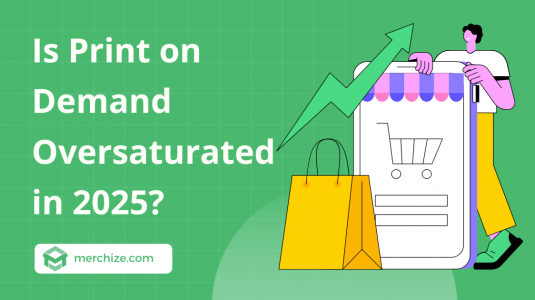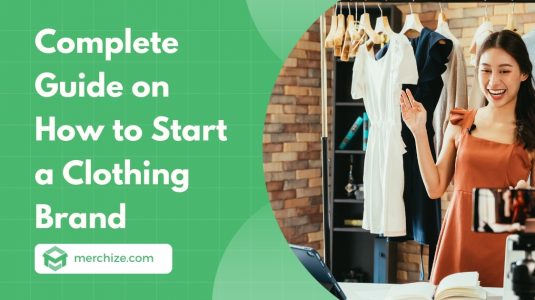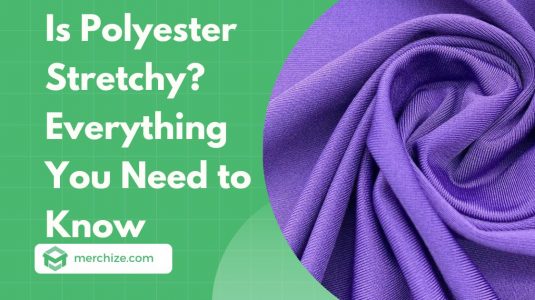Contents
Have you ever heard of ‘print on demand’? It’s actually a business model where you don’t have to keep any inventory. This means that you can start an online store without having to invest in a lot of upfront capital. Here’s the fun part: when someone buys something, you simply print the product when it’s ordered and then ship it straight out to them. This makes print on demand passive income an excellent method to boost earnings.
Now, if you’re wondering what passive income is, it is income that you earn without having to actively work for it. Here’s the cherry on top: with print on demand, you whip up products and designs just once, but get to sell them repeatedly. Yup, that’s right – you can cash in even when you’re taking a break from your business.
So, if diving into an online venture without a hefty startup cost sounds appealing and the potential to generate passive income, then print on demand is a great option.
Is the Print on Demand Good for Passive Income?
Yes, print on demand can be good for passive income. Firstly, for those unfamiliar, POD operates on a simple premise. Your cool designs are only made a reality when someone decides to buy, wiping out the need for stockpiles, big storage spaces, and all those headaches we usually associate with selling product. Your main job? Whip up awesome designs and team up with a solid POD agency that gets your vibe. The agency shoulders the bulk of operational challenges, allowing you to primarily focus on creativity and marketing.
Sounds splendid, doesn’t it? Indeed, the advantages are hard to overlook:
- Inclusivity: You don’t need to be a design wizard to jump into the POD scene. Given the bunch of design tools out there, creating marketable designs is more accessible than ever.
- No mass prints: Your artsy creations only get printed when someone bought it, so it won’t waste your resources.
- Technical Assistance: Numerous POD platforms handle the operational intricacies, allowing you to focus on design and marketing.
- Lower risk: Many POD sites don’t ask for money upfront, so less money risks for newbies.
Print on demand is a great way to start a business with low startup costs and the potential to earn passive income. You can watch the video 10 reasons why you should start a print on demand business for more details.
But it’s not all sunshine and rainbows. Like any business way, POD has its downers. Having tons of people use your design to sell it cheaper. Also, the quality of the stuff you’re selling, how it’s printed, and getting it to the buyer – that’s all on your chosen POD partner, so really check out possible partners. Besides, keeping an ear out, knowing what folks like, and keeping up with hot trends is key to keep winning.
How to Find a Profitable Niche
Selecting a niche is arguably the most critical decision in starting a print-on-demand business. Finding the perfect mix between what you love and making money can set your venture on the winning streak. Let’s dig into the tricks and tips to find that ideal print on demand niche.
Step #1. Begin with Passion: Self-Reflection and Interests
Your adventure starts with introspection. Understanding what you’re crazy about and where your expertise lies can help in crafting designs that resonate with authenticity. Consider these questions:
- What hobbies or interests genuinely excite you?
- Do you possess any shop know-how or professional crossover skills, like graphic design?
- Which products often catch your eye while shopping?
- Are there items you’ve always wanted to own?
Based on your thoughts, list down at least five niches you’re passionate about that can easily turn into print-on-demand products, focusing on trendy items like fashion, home goods, and accessories.
If you love football, building a football niche is completely reasonable. If you have small resources, you can build a football team like the Kansas City Chiefs store. Depending on your preferences, you can choose music, family, animals, jobs, holidays,…
Step #2. Pivot to Profit: Current Trends and Market Analysis
While passion ignites your business, profit ensures its staying alive. Begin by researching current trends around your shortlisted niches.
Tools to Assist Your Search:
- Google Trends: A super useful, free tool that provides insights on keyword popularity over time. It can hint at emerging trends or losing popularity in specific niches.
- Google Adwords: Especially its Keyword Planner, helps in understanding keyword demand. Aim for primary keywords with at least 10,000 searches per month and related terms with around 50,000.
- Trendhunter: A cool mix of insights, this platform is a goldmine for niche inspiration. The ideas tab can spark creativity while the insights section, albeit paid, offers rich data details on consumer behaviors.
Step #3. The Grand Decision: Merging Passion with Profit
With your passion niches and market trends at hand, now’s the time to decide. Go for a niche that:
- Aligns with both your passion and profit considerations.
- Targets a clear, sizable customer base.
- Offers an extensive product variety suitable for POD.
- Can be easily handled based on your skills and resources.
- Receives positive feedback from peers or potential customers.
Trending Niches to Consider in 2025:
- Fashion: Always in trend with lots of product ideas from tees to accessories.
- Animals and Pets: Leverage the strong connection people share with their furry friends with cute designs.
- Humor: Light-hearted, clever designs always find takers.
- Jobs and Hobbies: Serve and shout-out to individual professions and pastimes.
- Health and Fitness: As the global focus shifts towards well-being, this niche has gained super fame.
The journey to finding your perfect print-on-demand niche demands a blend of deep thinking, serious market check, and an eye on emerging trends. With the right niche, your business stands poised for both fulfillment and financial success.
How to Open a Print on Demand Store
Embarking on a print-on-demand business requires a strategic approach. Between selecting an eCommerce platform, setting up the store, and choosing a supplier, there are big choices to make. Here’s a comprehensive guide to launch your store seamlessly.
a. Deciding Between an eCommerce Marketplace and an eCommerce Platform
When diving into the print-on-demand world, one primary decision is where to house your products. Here’s a brief comparison:
eCommerce Marketplace:
Platforms like Etsy, eBay, Amazon and Walmart serve as busy online markets have a lot of potential customers. Here, businesses offer their products side by side. Starting on such platforms can be advantageous as they already have a ready crowd. The key is to optimize product listings with appropriate keywords to increase visibility.
eCommerce Platform:
Want a more personalized touch? Platforms such as Shopify, WooCommerce, and BigCommerce allow you to craft a unique store that aligns with your brand identity. While it provides a custom feel, you’ll have to actively direct traffic to your site, perhaps via marketing strategies or sharing on socials.
b. Setting Up Your Online Store
Once you’ve picked on your favorite channel, the next step is actually making your store. The exact procedure may vary based on the platform, but most offer either:
- A ready-to-use interface.
- Customizable templates to shape the store your way.
Dedicate time and attention to this phase, assure your store not only looks appealing but is also user-friendly.
c. Picking a Trusty Supplier: Enter Merchize
A successful print-on-demand business leans heavily on a dependable supplier, responsible for printing and shipping products. Merchize – Your Go-To Supplier Solution:
- Easy-to-use Platform: An easy peasy interface to sell unique items.
- No Upfront Costs: Start without any initial investments and pay after selling.
- Effortless Integration: Link Merchize with top eCommerce platforms and marketplaces.
- Huge Product List: With over 350 top-notch product and always adding more, lots to choose from.
- Order Whatever You Want: Whether it’s one product or a hundred, no low limit.
- 24/7 Help: An always-there help team addresses any questions, making things run smoothly.
By trusting your POD service to Merchize, you join an elite group of over two million global merchants. We are here to assist you to boost your earnings with less hassle.
How to Create High-Quality Designs
For both newbies and experienced folks, tools like Canva offer easy design fun. If you’re already an artist or designer, you probably make awesome designs or at least get the gist. With the help of cool design tools like Canva, you can take your work to the next level.
I started making money on print on demand sites using designs I whipped up on Canva Pro. Trust me, it’s super easy to make standout designs that are ready for product printing at Merchize.
You can dive right into creating your own designs with Canva’s freebie. That said, I’m all about loads of cool features that come with Canva Pro, especially the ability to easily change my designs’ size to fit usual print sizes and merch rules. With Canva Pro, I can create high-quality designs that look professional and polished, without having to waste hours figuring out tricky design software.
If you’re on the hunt for a way to make wow designs without the fuss, I totally suggest giving Canva Pro a shot. You can hop on for a free tryout today and see for yourself how chill it is to make awesome designs that really pop.
Selling print on demand on Amazon can be a great way to make money. Learn how to do it in my blog post!
How to Market Your Print on Demand Business
Marketing effectively bridges the gap between your offerings and potential clients. Here’s a refined guide to ensure your print on demand store not only captures the right audience but also achieves robust sales.
1. Showcase Your Designs out there
Please publish your products without overthinking minor details. While aiming for perfection is natural, to achieve perfection takes a long process, sell what you have and improve your skills gradually.
For example, constantly revising your pricing might not be necessary. After your store is live, you can gauge if your prices are right based on conversion rates. Remember, the real feedback comes when your products are out in the market. Learn from the reactions and adjust accordingly.
Begin with a select number of standout designs you believe in. Then, channel your energy towards crafting persuasive product descriptions.
2. Write Compelling Content
What you write is like your business’s first impression. It’s what possible buyers see first. It’s super important because it gives them their first thought about you. That’s why you gotta make sure it’s to the point, catchy, and grabs them. When you nail it, your writing can draw in more possible buyers and get them curious about what you do. Plus, it boosts your trustworthiness, which helps in making sales. On the flip side, bad writing can turn them off or mess up how they see you, making you seem not pro and someone they can’t trust.
3. Detailed Product Info
Good product details provide valuable insights like size, fit, material quality, and more. While crafting them, visualize yourself as the consumer. Address their questions and curiosities.
Ensure your descriptions:
- Write in your own voice
- Focus on what the product can do for the customer over features.
- Are easy to understand. Tip: Use bullet points for clarity.
- Leave out the unclear to prevent potential customers.
4. Optimize your descriptions for search engines
A key part of your descriptions is SEO: refining your content to boost your site’s visibility on search engines. This strategy draws in organic traffic.
Explore our article, A Beginner’s Guide to SEO out there, to understand:
How search engines work and search engine mechanics.
- Tools to help you improve your SEO
- Techniques to improve your website’s ranking in search engines
- Quick references in our SEO glossary.
With this guide, you’re on the right path to making your Print on Demand Business stand out and flourish. To write more outstanding content, read the full blog post to learn more about how to write a product description that sells.
5. Benefit of free marketing channels
Before jumping into paid ads, first explore the bunch of marketing ways available for free. Social media’s still a big deal in today’s online marketing scene.
Focus on mastering just a couple of platforms rather than stretching yourself thin across all. The three main points for all platforms are: produce high-quality content, put value first over sales, and really chat with your audience.
Below, we dive into the details of three big social media sites you can use without paying a dime. Get why they’re cool and tactics to get the best from each.
Reddit – The Front Page of the Internet
Reddit is a bunch of communities known as subreddits. It offers a unique voting mechanism where users upvote or downvote content, bringing the most appreciated content to the top.
- Engage Authentically: Redditors value real input. Jump in discussions, upvote valuable posts, and share insightful content.
- Beware of Over-Promotion: Follow the “Reddiquette" and individual subreddit rules. Too much self-promo can lead to getting banned.
- Build Trust First: Become a respected community member before showcasing your products. By being a genuine contributor, you set the stage for a loyal customer base.
- Further Reading: Comprehensive Guide on Using Reddit for Marketers
Facebook Groups – Nurturing Communities
With a lot of users, Facebook Groups offer a direct connection to potential customers.
- Optimize Your Group: Enhance discoverability with a catchy group description containing relevant keywords and clear CTAs.
- Set Clear Rules: Establish a set of rules to foster a safe and engaging environment.
- Engage with Varied Content: Mix up your posting plan with user-generated content, live videos, polls, and visually appealing images.
Instagram – Visual Storytelling
Boosting your brand on Instagram is super important given its standing as the second largest social media platform, with more than a billion active monthly users. A staggering 86% of US businesses tap into its potential, followed by 81% accounts from the U.K. and 75% from Germany-based online stores. When charting out an Instagram strategy, first figure out what you want. Here’s a brief guide:
- Sales-Oriented Posts: Showcase your products attractively. For instance, Anthropologie posts images of trendy outfits, effectively encouraging sales.
- Portfolio Displays: For creatives, Instagram can serve as a visual portfolio. Artists like Toyin Ojih Odutola share their masterpieces to connect with fans and gain recognition.
- Brand Messaging: Share motivational quotes or engaging visuals like the serene cat drawing, ensuring your brand’s essence resonates.
Really rock it, curate content aligning with your brand’s voice and the interests of your audience.
TikTok – Unleash Your Creativity
Getting your brand out there on TikTok can really change the game, considering its staggering 1 billion monthly active users. To tap into this creative and youthful community, you gotta know who you’re trying to reach. TikTok is mostly about folks aged 10-29, and a bunch of them are girls.
If this matches your target crowd, start by making your own branded channel and trying out different quick vids. TikTok thrives on no-dough, quick vids. Engage with popular tags and memes related to your brand. Adapt these trends creatively to make your content stand out.
By embracing TikTok’s fun vibe and knowing your audience, you can effectively promote your brand, get people involved, and make more money. So, jump into TikTok’s vibrant world and watch your brand flourish.
6 Consider paid advertising
Paid advertising is awesome for getting a quick traffic boost and ramping up your sales. Now, when it comes to advertising, you’ve got a bunch of social media platforms to pick from, but the top three heavy hitters are:
Facebook Ads
So, let’s talk about Facebook first. This platform is a real champ when it comes to reaching a massive audience with your ads. The cool thing is, you can get super specific with who sees your stuff – think demographics, interests, and even what they’ve done before. Basically, you’re showing your ads to the folks who are most likely into what you’re offering.
Now, check out the upsides and downsides of using Facebook ads:
Pros:
- Massive reach: With 3.35 billion billion active users, you’ve got a shot at reaching a ginormous crowd.
- Targeted audience: You can zero in on your ideal audience based on their deets, making sure your ads hit the right peeps.
- Budget-friendly: Especially if you’re just starting out, Facebook ads won’t break the bank.
Cons:
- Competitive: Since everyone and competition can be advertised on Facebook, it can get pretty competitive, which might hike up your ad costs.
- Requires expertise: To squeeze the most juice out of Facebook ads, you’ll need to know your way around creating and managing them.
Here’s some Facebook ad into:
- A funny ad for your new thingamajig.
- A video ad that spins a tale about your brand.
- A carousel ad that showcases multiple products or services
- A lead-gen ad that hands out a freebie ebook or consultation.
Instagram Ads
Next up, we’ve got Instagram. It’s another rad choice for getting your ads in front of a big audience. Especially if you’re after the younger crowd, this is the place to be.
Let’s peep at the pros and cons of Instagram ads:
Pros:
- High engagement: People on Instagram are more likely to hit that like and comment button on ads compared to other platforms.
- Super visual: Instagram is all about the visuals, so your ads better look snazzy.
- Budget-friendly: Just like with Facebook, Instagram ads can be pretty kind to your wallet.
Cons:
- Competitive: The competition here is fierce too, which can drive up your ad costs.
- Know-how required: To get the most bang for your buck with Instagram ads, you have got to know how to make and handle them.
Some Instagram ad ideas:
- A slick photo ad flaunting your content.
- A video ad with a story about your brand.
- A carousel ad showcasing your lineup.
- A story ad sharing a more personal side of your brand.
LinkedIn Ads
Last but not least, LinkedIn is where the pros hang out. If you’re aiming at businesses or pros, this is your jam. LinkedIn ads are gold for generating leads and sending folks to your website.
Now, let’s break down the good and the not-so-good about LinkedIn ads:
Pros:
- Targeted to the max: You can aim your ads at folks based on their job, company, industry, and more, making sure your ads land in front of the right eyes.
- Top-notch leads: LinkedIn users are usually pretty qualified leads compared to other social media peeps.
- Budget-friendly: Yep, even LinkedIn ads can be a steal if you’re just getting started.
Cons:
- Smaller crowd: LinkedIn’s audience is smaller compared to Facebook or Instagram.
- Know-how needed: To make the most out of LinkedIn ads, you’ll want to be comfortable creating and managing them.
7. Look into influencer marketing
Influencer marketing rocks for reaching a new crowd and boosting your business. When you do it right, it’s a budget-friendly and powerful way to get more leads and sales.
How to find influencers
The first step is to find influencers who are relevant to your target audience. You can start by searching for hashtags related to your field on social media. For example, if you sell print on demand t-shirts, you would want to find influencers who create content related to fashion or style by finding the hagtash #fashion,#style, #ootd (outfit of the day), #fashionblogger. Or you can use influencer marketing platforms like Upfluence or Traackr to hunt them down.
What to check in an influencer
When picking an influencer, keep these things in mind:
- Their follower count: It shows how many people follow them, but it’s not the whole story.
- Their engagement rate: It reveals how often their followers engage with their content.
- The quality of their content: Make sure their content speaks to your crowd and looks top-notch.
- Their authenticity: You want influencers who are real and true to themselves.
How to get in touch with an influencer
After you’ve spotted some influencers you want to team up with, it’s time to shoot them a message. Introduce yourself and your biz, and tell them why you think they’d rock your campaign. Be straight up about what you want in terms of content and promotion.
What you can give an influencer
You’ve got a few options to sweeten the deal for an influencer. Here are some usual ones:
- Free products or services
- Money
- Access to your brand’s followers
- Special content or discounts
How to see how things are going
You’ve got to keep an eye on how your influencer marketing is doing to know if it’s working. You can do this by checking stuff like:
- The number of impressions your content received
- How many clicks your content got
- How many sales you bagged
- How much it costs to get a lead or make a sale
In conclusion, Print on Demand offers a promising avenue for passive income. By selecting a profitable niche, establishing a seamless online store, creating high-quality designs, and leveraging diverse marketing channels, entrepreneurs can unlock the full potential of this business model. Paid advertising, while effective, should be approached strategically to maximize returns.











